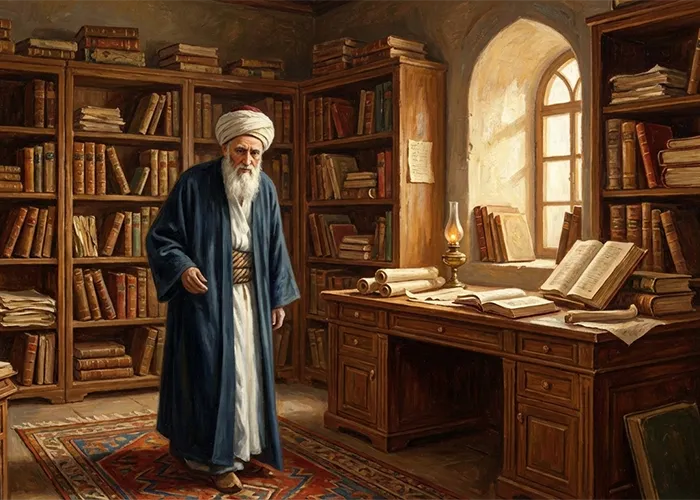Topic of the Week – Volume02 Issue48
Shaykh al-Mufīd: Architect of Uṣūl al-Fiqh and Defender of Imāmī Theology in the Fourth Century – A Model for Today’s Ijtihād and Scholarly Dialogue
Seyed Hashem Moosavi
Introduction
The 4th/10th century marks a golden age in the formation of Islamic sciences in Baghdad. During this period, the city stood at the heart of intellectual exchange-an active hub of theological debate, legal reasoning, and the flourishing of both transmitted and rational sciences. With a vibrant presence of diverse theological and legal schools, Baghdad cultivated an unprecedented atmosphere of debate and knowledge production.
It was in this dynamic environment that Muḥammad b. Muḥammad b. al-Nuʿmān – widely known as Shaykh al-Mufīd (336-413 AH) – emerged as one of the most influential figures of Imāmī thought. A jurist with rigorous methodological insight, a distinguished theologian, and a versatile scholar, Shaykh al-Mufīd elevated the structures of Shīʿi jurisprudence and theology to a new level of sophistication. He is regarded not only as a pioneer of the discipline of uṣūl al-fiqh but also as one of the firmest defenders of Imāmī kalām and a foundational architect in shaping Shīʿi legal and intellectual identity.
Modern scholarship affirms that it is impossible to understand the development of Imāmī fiqh and theology without understanding the pivotal role of Shaykh al-Mufīd. At a time when the Muslim world faces new questions, emerging discourses, and an urgent need for principled scholarly dialogue, revisiting Shaykh al-Mufīd’s legacy has gained renewed significance. His work offers a compelling model of methodical ijtihād, ethical debate, and faith-anchored rationality.
(See: Madelung & Modarressi, The School of al-Mufīd; Hossein Modarressi, Crisis and Consolidation in the Formative Period of Shi‘ite Islam)
- Historical and Intellectual Context: Baghdad of the Schools
Shaykh al-Mufīd lived during the Buyid era, a period marked by remarkable religious and intellectual diversity. This era, known for its relative academic freedom, became a dynamic arena where major theological and legal traditions-Imāmīs, Mu‘tazilites, Ash‘arites, Ḥanbalīs, and the Ahl al-Ḥadīth-confronted one another directly. Historical sources note that Shaykh al-Mufīd’s study circle in Baghdad regularly hosted scholars and theologians from these various traditions. Such a multi-sectarian environment cultivated in him an exceptional mastery of debate, precision in argumentation, and intellectual courage. (Najāshī, Rijāl; al-Ṭūsī, al-Fihrist)
Historians such as Ibn al-Nadīm, in his al-Fihrist, record several of al-Mufīd’s debates with leading Sunnī scholars of the time, including the Mu‘tazilī judge ʿAbd al-Jabbār and Abū Bakr al-Bāqillānī. These encounters reveal not only his formidable scholarly stature but also the reverence he earned even among his intellectual opponents. His debates helped elevate the standing of Imāmī theology within the broader Islamic intellectual world while fostering mutual respect across theological boundaries
- Shaykh al-Mufīd: The Architect of Shīʿī Uṣūl al-Fiqh
Although the full codification of Shīʿī legal theory (uṣūl al-fiqh) reached its maturity in the works of al-Sharīf al-Murtaḍā and Shaykh al-Ṭūsī, a significant part of the conceptual “architecture” of this discipline is rooted in the intellectual innovations of Shaykh al-Mufīd. His contributions may be summarized in several key areas:
2.1. Integrating Reason and Revelation
(Methodical Rationalism)
Al-Mufīd sought to move legal theory beyond a purely transmitted discipline and ground it in rational principles, firm methodological rules, and logical analysis. As al-Sharīf al-Murtaḍā remarks in al-Fusūl al-Mukhtāra, and as Shaykh al-Ṭūsī confirms in ʿUddat al-Uṣūl, al-Mufīd was the scholar who transformed Shīʿī legal theory from its early “tradition-centred” phase into a mode of “disciplined rationalism.”
2.2. Redefining the Authority of Hadith Reports
Shaykh al-Mufīd was among the earliest jurists to systematically employ isnād criticism, evaluate the trustworthiness of narrators, and analyse the impact of conflicting traditions. In response to the early proto-Akhbārī tendencies, he rejected unreliable reports and emphasized rigorous “narrative filtration”.
In al-Muqniʿa, he explicitly states: “One may not act upon a report unless it is established through a trustworthy method.”
This foundational stance paved the way for a more refined systematization of hadith evaluation in the works of Shaykh al-Ṭūsī and later scholars.
2.3. Strengthening the Foundations of Ijtihād
Al-Mufīd defined ijtihād as “the process of uncovering the divine ruling through definitive or valid probabilistic evidence” (as cited in al-Sharīf al-Murtaḍā’s al-Dhariʿa ilā Uṣūl al-Sharīʿa).
This approach lifted ijtihād beyond a mechanical adherence to texts and provided a framework for dynamic reasoning, methodological engagement, and the disciplined effort to discern the intention of the Lawgiver. It is precisely this vision that later matured into the fully developed uṣūlī school of Shīʿī legal thought.
- Shaykh al-Mufīd and the Renewal of Imāmī Theology
Imāmī kalām began to take shape with Shaykh al-Ṣadūq, but it was Shaykh al-Mufīd who gave it structure, coherence, and intellectual depth. His major theological works-such as Awāʾil al-Maqālāt, Tashīḥ al-Iʿtiqād, al-Irshād, and al-Nukat al-Iʿtiqādiyya-demonstrate how he laid down the foundational pillars of Imāmī theology and articulated its doctrines with clarity, rigor, and rational precision.
Some of the most important features of his theological contribution include the following:
3.1. Rationalizing Shīʿī Doctrines
Unlike Shaykh al-Ṣadūq, whose approach leaned heavily toward tradition and hadith, Shaykh al-Mufīd advanced a rationally grounded exposition of Imāmī beliefs. His method shows clear influence from Mu‘tazilī argumentative techniques, yet he employed them entirely in service of defending and reinforcing core Shīʿī doctrines. In his writings, every major belief-from divine justice to human agency and from prophecy to eschatology-is systematically discussed with reasoned proofs aligned with transmitted texts.
3.2. A Systematic Defence of the Doctrine of Imamate
Given the intellectual climate of Baghdad, the doctrine of imāmah was the central point of theological contention. Shaykh al-Mufīd approached this subject through a combined historical, rational, and scriptural method. He was the first to articulate the theory of Imamate in a clearly structured academic format.
In works such as al-Irshād and al-Masāʾil al-ʿUkbariyya, he argued for:
- the necessity of divinely appointed leadership,
- the infallibility (ʿiṣma) of the Imām,
- the Imām’s divinely granted knowledge, and
- the Imām’s religious, political, and social role.
This structured presentation became the basis upon which al-Sharīf al-Murtaḍā and Shaykh al-Ṭūsī later developed the mature Shīʿī theological tradition.
3.3. Scholarly Debate as a Method
One of Shaykh al-Mufīd’s defining qualities was his disciplined and respectful approach to scholarly dialogue. Historical accounts indicate that even in the midst of intense disagreement, he upheld intellectual courtesy toward his opponents. This approach earned him widespread respect—so much so that even adversaries referred to him as al-Mufīd (“the Beneficial”).
Classical sources such as al-Shahrastānī’s al-Milal wa-l-Niḥal and Ibn al-Nadīm’s al-Fihrist note that three characteristics distinguished him in debate:
- Fairness in reasoning,
- Intellectual sharpness and agility,
- Avoidance of non-academic polemics.
These traits made him a model of scholarly engagement whose style remains exemplary for contemporary inter-sectarian and interfaith dialogue.
- Scholarly and Educational Legacy
One of Shaykh al-Mufīd’s most enduring contributions lies in the generation of scholars he trained-a golden cohort that defined the trajectory of Shīʿī thought for centuries. Among his direct students were al-Sharīf al-Murtaḍā and Shaykh al-Ṭūsī, both of whom later became foundational architects of Shīʿī jurisprudence and theology.
In al-Fihrist, Shaykh al-Ṭūsī offers a striking testimony:
«ما عَلِمنا أحداً کان أقدرَ علی التدریس و تنظیر المسائل منه
“We have not known anyone more capable than him in teaching and in constructing theoretical arguments.”
Such a statement, coming from one of the most influential jurists in Islamic history, stands as a powerful confirmation of al-Mufīd’s exceptional pedagogical authority.
- The Contemporary Relevance of Shaykh al-Mufīd’s Model
Revisiting the persona and methodology of Shaykh al-Mufīd is not merely an exercise in historical admiration; it offers timely guidance for today’s intellectual and religious challenges.
5.1. A Model of Learned, Reason-Centred Ijtihād
In an era where certain discourses tend toward rigid literalism on one side or extreme anti-intellectualism on the other, Shaykh al-Mufīd embodies a balanced, integrated, and methodologically disciplined form of ijtihād.
His legacy illustrates a harmonious interplay between:
- fidelity to scriptural texts,
- principled use of reason,
- rigorous hadith scrutiny, and
- adherence to systematic juristic method.
The intellectual crises of the modern Muslim world call for precisely this kind of wise and principled ijtihād.
5.2. A Model for Scholarly Dialogue in a Plural Religious World
Today’s globalized Muslim community-facing interfaith challenges, sectarian sensitivities, and a complex media landscape-stands in urgent need of respectful and intellectually grounded dialogue. Shaykh al-Mufīd’s approach to debate, marked by argumentation free from hostility, careful representation of opposing views, and unwavering scholarly etiquette, provides a vital model for constructive engagement in multi-religious societies.
5.3. A Model of Rational Defence of the Imāmī Tradition
Al-Mufīd demonstrated that defending religious beliefs is most effective not through emotion or partisanship, but through:
- critical analysis,
- textual evidence,
- coherent argumentation, and
- a deep understanding of alternative perspectives.
His method remains a powerful blueprint for presenting and defending the Imāmī school in the modern intellectual arena.
Conclusion
Shaykh al-Mufīd was not merely a great jurist and theologian of his time; he was the architect of Shīʿī intellectual identity in the 4th/10th century and the founder of many of the scholarly principles that continue to shape the seminaries today. His brilliance in legal theory, his rational methodology in theology, his truth-seeking spirit in debate, and his profound influence as a teacher all combine to make him a timeless model for contemporary scholars, preachers, and thinkers.
Shaykh al-Mufīd can rightfully be seen as the transitional bridge between the early hadith-centred phase of Imāmī scholarship and the later rationalist, uṣūlī school. His pioneering work in three major domains:
- laying the conceptual foundations of uṣūl al-fiqh,
- renewing and systematizing Imāmī theology, and
- training the generation that would build classical Shīʿī jurisprudence, elevated him to the status of one of the principal pillars of Shīʿī thought in the 4th century.
To revisit his legacy is to return to three enduring values:
- rationality in understanding religion,
- scholarly ethics in dialogue, and
- methodical ijtihād in addressing contemporary needs.
These values were not only the core of Shaykh al-Mufīd’s intellectual project-they remain essential requirements for the Muslim world in our time.
editor's pick
news via inbox
Subscribe to the newsletter.




